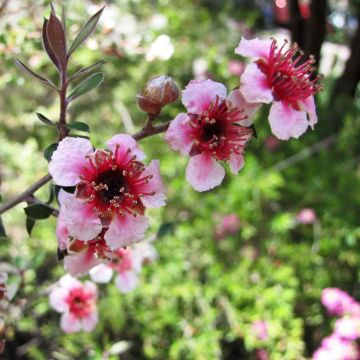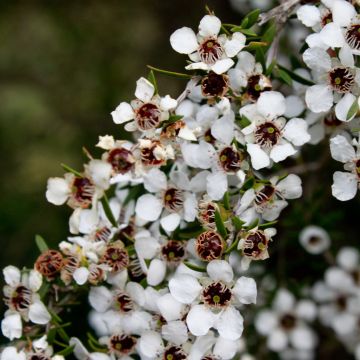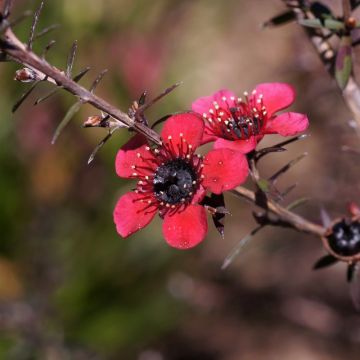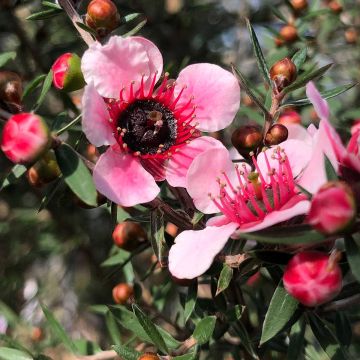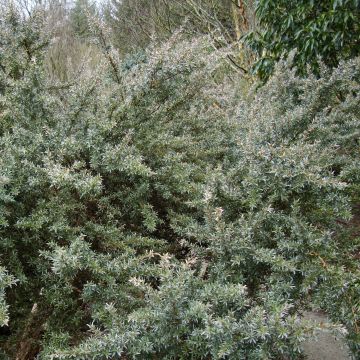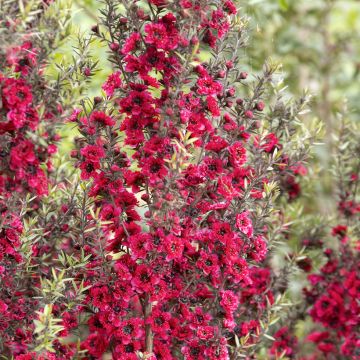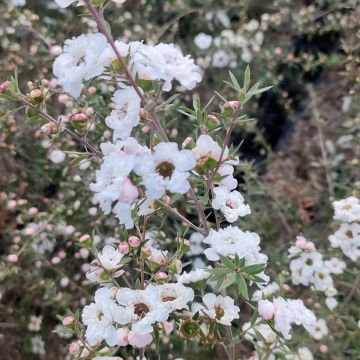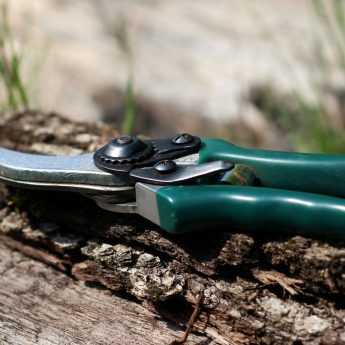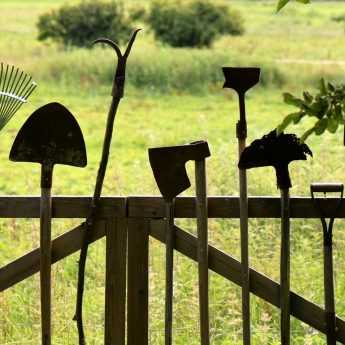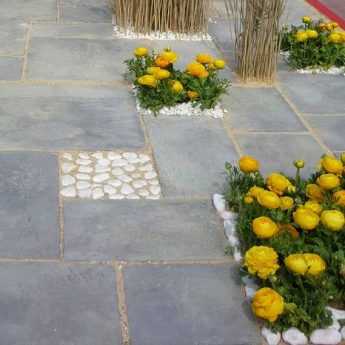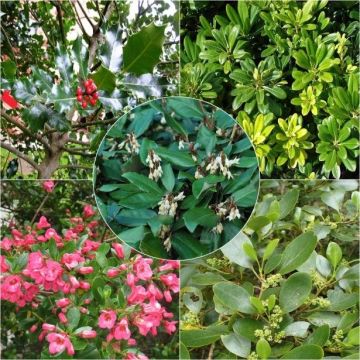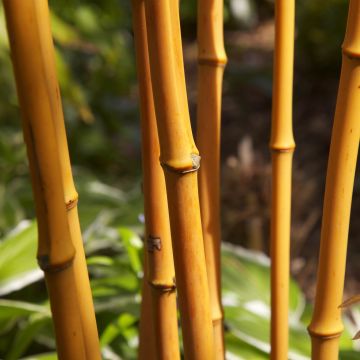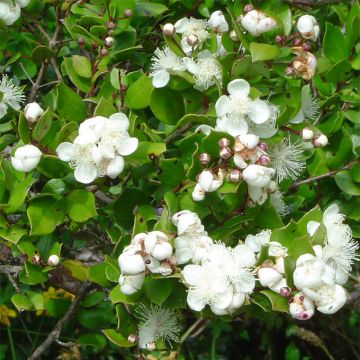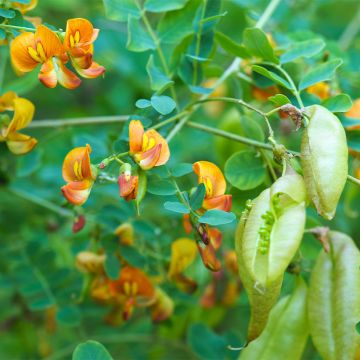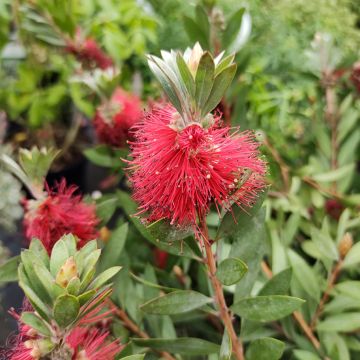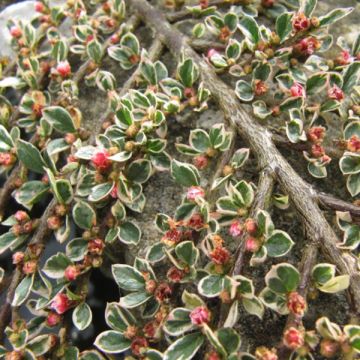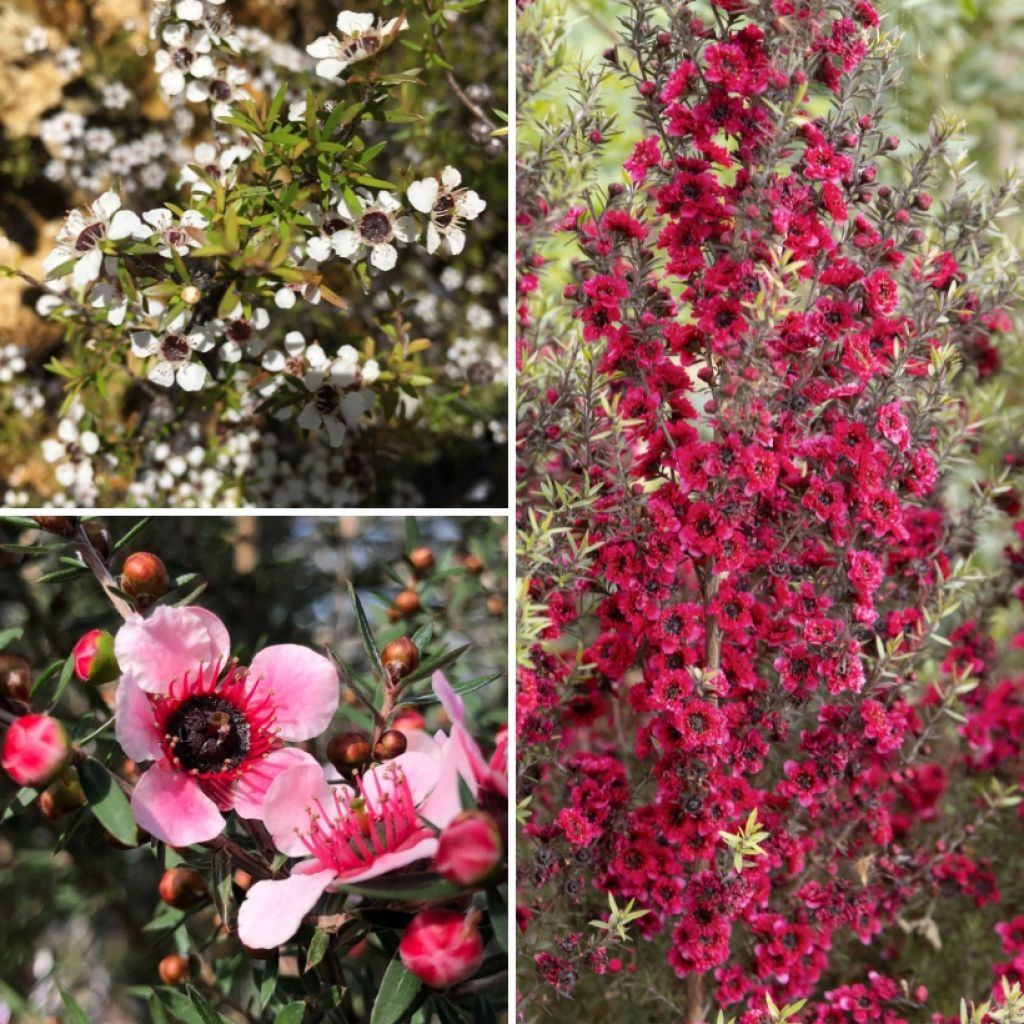

Collection of Leptospermum
Collection of Leptospermum
Leptospermum scoparium Red Damask, alba et Martini
Manuka, New Zealand Tea Tree, Tea Tree, New Zealand Myrtle
Home or relay delivery (depending on size and destination)
Schedule delivery date,
and select date in basket
This plant carries a 24 months recovery warranty
More information
We guarantee the quality of our plants for a full growing cycle, and will replace at our expense any plant that fails to recover under normal climatic and planting conditions.
Does this plant fit my garden?
Set up your Plantfit profile →
Collection items (0 plants)
Description
This is a collection of Leptospermum, Australian shrubs also known as New Zealand tea tree or Manuka. It consists of three different varieties, distinguished by their flowering or their growth. They are evergreen shrubs with low hardiness, cultivated for the generosity of their flowering, which extends along the branches from April to July. In coastal gardens, they have a great effect as a shrub border or integrated into a hedge. Elsewhere, they will be superb in large pots on the terrace or balcony! They should be grown in non-calcareous (acid or neutral), light soil, even dry in summer.
The collection consists of:
1 Leptospermum scoparium 'Red Damask': reaching 1.30 m to 1.50 m in all directions, this variety produces double, red flowers measuring 2 to 3 cm in diameter. Slightly fragrant and nectar-rich, they appear from April to July, sometimes from March to December in Mediterranean climates. Its small leaves are dark green with brownish and greyish reflections. Hardiness: -8°C at the coldest.
1 Leptospermum scoparium 'Album': this more vigorous variety reaches a height of 3 m and spreads over 2.50 m, so it should be planted behind the other two. It bears single, white flowers with a black centre and very fine, dark green, delicate and aromatic foliage. Hardiness: -6/-7°C at the coldest.
1 Leptospermum scoparium 'Martini': an intermediate-sized variety, wider than it is tall (1.50 m tall by 1.80 m wide), highly appreciated for its vigour, floribundity and accommodating character. Its flowers open in shades of pink.
Leptospermum can tolerate temperatures as low as -8°C at the coldest, but the above-ground parts can be damaged as soon as -5°C. This shrub requires some precautions to acclimate to open ground. It likes the sun and prefers light, non-calcareous, sandy or loamy soils. It has a great effect when planted as a medium-sized hedge or in a shrub border. A minimum distance of 1 m should be respected between each plant, up to 1.50 m in a border. The two shorter varieties should be planted in front of the white variety.
The combination of Leptospermum from this collection is ideal with other plants from southern regions such as Melaleuca gibbosa, Callistemon x laevis, Feijoa, persistent Ceanothus 'Concha' and Grevillea juniperina. Add some spring-flowering shrubs in front, such as Cistus purpureus or Cistus des Corbières to lighten the scene.
In pots, choose a container of 30 to 40 litres, with drainage holes, and place a layer of clay pebbles at the bottom to help with water drainage. Bring the pots indoors in October, like citrus trees, in a slightly heated veranda or a cool and bright room.
Report an error about the product description
Plant habit
Flowering
Foliage
Botanical data
Leptospermum
scoparium
Red Damask, alba et Martini
Myrtaceae
Manuka, New Zealand Tea Tree, Tea Tree, New Zealand Myrtle
Oceania
Other Leptospermum
View all →Planting and care
Leptospermum thrives in open ground in coastal regions spared from heavy frosts. It is best planted in spring, in full sun. It tolerates drought and poor soils, but not the presence of limestone. Plant it in light soil, for example, a well-drained mixture of leaf compost, ericaceous soil, and river sand. During planting, the hole should be twice the size of the root ball. Water regularly to aid in establishment. Once well established, Leptospermum can do without watering in summer.
Pruning is not essential, but you can prune moderately after flowering. Remove 1/3 the length of each flowering branch at the most.
Water plants grown in containers regularly. In cold regions, bring them indoors to a cool, bright, minimally heated room before the heavy frosts.
Planting period
Intended location
Care
Planting & care advice
This item has not been reviewed yet - be the first to leave a review about it.
Similar products
Haven't found what you were looking for?
Hardiness is the lowest winter temperature a plant can endure without suffering serious damage or even dying. However, hardiness is affected by location (a sheltered area, such as a patio), protection (winter cover) and soil type (hardiness is improved by well-drained soil).

Photo Sharing Terms & Conditions
In order to encourage gardeners to interact and share their experiences, Promesse de fleurs offers various media enabling content to be uploaded onto its Site - in particular via the ‘Photo sharing’ module.
The User agrees to refrain from:
- Posting any content that is illegal, prejudicial, insulting, racist, inciteful to hatred, revisionist, contrary to public decency, that infringes on privacy or on the privacy rights of third parties, in particular the publicity rights of persons and goods, intellectual property rights, or the right to privacy.
- Submitting content on behalf of a third party;
- Impersonate the identity of a third party and/or publish any personal information about a third party;
In general, the User undertakes to refrain from any unethical behaviour.
All Content (in particular text, comments, files, images, photos, videos, creative works, etc.), which may be subject to property or intellectual property rights, image or other private rights, shall remain the property of the User, subject to the limited rights granted by the terms of the licence granted by Promesse de fleurs as stated below. Users are at liberty to publish or not to publish such Content on the Site, notably via the ‘Photo Sharing’ facility, and accept that this Content shall be made public and freely accessible, notably on the Internet.
Users further acknowledge, undertake to have ,and guarantee that they hold all necessary rights and permissions to publish such material on the Site, in particular with regard to the legislation in force pertaining to any privacy, property, intellectual property, image, or contractual rights, or rights of any other nature. By publishing such Content on the Site, Users acknowledge accepting full liability as publishers of the Content within the meaning of the law, and grant Promesse de fleurs, free of charge, an inclusive, worldwide licence for the said Content for the entire duration of its publication, including all reproduction, representation, up/downloading, displaying, performing, transmission, and storage rights.
Users also grant permission for their name to be linked to the Content and accept that this link may not always be made available.
By engaging in posting material, Users consent to their Content becoming automatically accessible on the Internet, in particular on other sites and/or blogs and/or web pages of the Promesse de fleurs site, including in particular social pages and the Promesse de fleurs catalogue.
Users may secure the removal of entrusted content free of charge by issuing a simple request via our contact form.
The flowering period indicated on our website applies to countries and regions located in USDA zone 8 (France, the United Kingdom, Ireland, the Netherlands, etc.)
It will vary according to where you live:
- In zones 9 to 10 (Italy, Spain, Greece, etc.), flowering will occur about 2 to 4 weeks earlier.
- In zones 6 to 7 (Germany, Poland, Slovenia, and lower mountainous regions), flowering will be delayed by 2 to 3 weeks.
- In zone 5 (Central Europe, Scandinavia), blooming will be delayed by 3 to 5 weeks.
In temperate climates, pruning of spring-flowering shrubs (forsythia, spireas, etc.) should be done just after flowering.
Pruning of summer-flowering shrubs (Indian Lilac, Perovskia, etc.) can be done in winter or spring.
In cold regions as well as with frost-sensitive plants, avoid pruning too early when severe frosts may still occur.
The planting period indicated on our website applies to countries and regions located in USDA zone 8 (France, United Kingdom, Ireland, Netherlands).
It will vary according to where you live:
- In Mediterranean zones (Marseille, Madrid, Milan, etc.), autumn and winter are the best planting periods.
- In continental zones (Strasbourg, Munich, Vienna, etc.), delay planting by 2 to 3 weeks in spring and bring it forward by 2 to 4 weeks in autumn.
- In mountainous regions (the Alps, Pyrenees, Carpathians, etc.), it is best to plant in late spring (May-June) or late summer (August-September).
The harvesting period indicated on our website applies to countries and regions in USDA zone 8 (France, England, Ireland, the Netherlands).
In colder areas (Scandinavia, Poland, Austria...) fruit and vegetable harvests are likely to be delayed by 3-4 weeks.
In warmer areas (Italy, Spain, Greece, etc.), harvesting will probably take place earlier, depending on weather conditions.
The sowing periods indicated on our website apply to countries and regions within USDA Zone 8 (France, UK, Ireland, Netherlands).
In colder areas (Scandinavia, Poland, Austria...), delay any outdoor sowing by 3-4 weeks, or sow under glass.
In warmer climes (Italy, Spain, Greece, etc.), bring outdoor sowing forward by a few weeks.


































